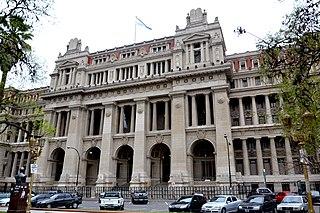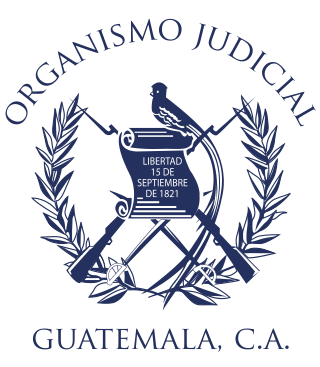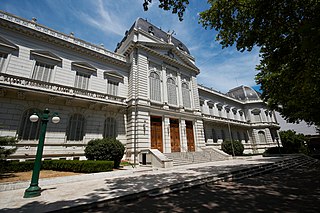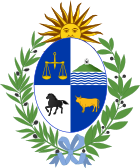
The Supreme Court of Justice of the Nation is the Mexican institution serving as the country's federal high court and the spearhead organisation for the judiciary of the Mexican Federal Government. It consists of eleven magistrates, known as ministers of the court, one of whom is designated the court's president.

The Supreme Court of Argentina, officially known as the Supreme Court of Justice of the Argentine Nation, is the highest court of law of the Argentine Republic. It was inaugurated on 15 January 1863. However, during much of the 20th century, the Court and the Argentine judicial system in general, lacked autonomy from the executive power. The Court was reformed in 2003 by the decree 222/03.

The General Council of the Judiciary is the national council of the judiciary of Spain. It is the constitutional body that governs all the Judiciary of Spain, such as courts, and judges, as it is established by the Spanish Constitution of 1978, article 122 and developed by the Organic Law 6/1985 of the Judicial Power (LOPJ). The President of the CGJP is also the president of the Supreme Court.

In most legal jurisdictions, a supreme court, also known as a court of last resort, apex court, and highcourt of appeal, is the highest court within the hierarchy of courts. Broadly speaking, the decisions of a supreme court are binding on all other courts in a nation and are not subject to further review by any other court. Supreme courts typically function primarily as appellate courts, hearing appeals from decisions of lower trial courts, or from intermediate-level appellate courts. A Supreme Court can also, in certain circumstances, act as a court of original jurisdiction, however, this is typically limited to constitutional law.

The Supreme Court is the highest court in the Kingdom of Spain. Originally established pursuant to Title V of the Constitution of 1812 to replace —in all matters that affected justice— the System of Councils, and currently regulated by Title VI of the Constitution of 1978, it has original jurisdiction over cases against high-ranking officials of the Kingdom and over cases regarding illegalization of political parties. It also has ultimate appellate jurisdiction over all cases. The Court has the power of judicial review, except for the judicial revision on constitutional matters, reserved to the Constitutional Court.

The Supreme Court of Justice of Colombia in Bogotá is the highest judicial body in civil and penal matters and issues of criminal and civil procedure in Colombia.

The Judiciary of Spain consists of Courts and Tribunals, composed of judges and magistrates (Justices), who have the power to administer justice in the name of the King of Spain.

The Supreme Court of Justice of El Salvador is the highest court of El Salvador. The court sits in San Salvador. The current president is Judge Óscar Alberto López Jerez.

The Supreme Court of Honduras is the Supreme Court and Constitutional Court of Honduras. The Supreme Court is the highest judicial authority in Honduras.

The judiciary of Italy is composed of courts responsible for interpreting and applying the law in the Italian Republic. Magistracy is a public office, accessible only to Italian citizens who hold an Italian Juris Doctor and have successfully participated in the relevant competitive public examination organised by the Ministry of justice. The judicial power is independent and there is no internal hierarchy within. Italian magistrates are either judges or public prosecutors.
The Supreme Court of Justice is the highest court of ordinary jurisdiction in Bolivia, based in Sucre. Its powers are set out in Articles 181–185 of the 2009 Constitution and the Law of the Judicial Organ. It was first seated on 2 January 2012.

The judiciary of Uruguay is a branch of the government of Uruguay that interprets and applies the laws of Uruguay, to ensure equal justice under law, and to provide a mechanism for dispute resolution. The legal system of Uruguay is a civil law system, with public law based on the 1967 Constitution, amended in 1989, 1994, 1997, and 2004. The Constitution declares Uruguay to be a democratic republic, and separates the government into three equal branches, executive, legislative and judicial. Private relationships are subject to the Uruguayan Civil Code, originally published in 1868. The Constitution defines the judiciary as a hierarchical system courts, with the highest court being a five-member Supreme Court, who are appointed by the legislative branch of the government, for ten-year terms. The Supreme Court appoints the judges of most of the lower courts. Below the Supreme Court, there are sixteen courts of appeal, each of which has three judges. Seven of the courts of appeal specialize in civil matters, four specialize in criminal matters, three cover labour law, and two focus on family matters. At the lowest tier are justices of the peace and courts of first instance specialized in administrative, civil, criminal, customs, juvenile, and labour cases. Although the hierarchy, all of them are functionally and structurally impartial, that is, the tribunal should not be interested in the object of the particular case, and the higher tribunal does not impose a behaviour nor precedent to the lower ones. There are also separate courts for auditing, elections and the military.

The Supreme Court of the Dominican Republic is the highest court existing in the Republic and is, therefore, the head of the judiciary in the country.

The president of the Constitutional Court of Spain is the head of the Constitutional Court, the highest body with the power to determine the constitutionality of acts of the Spanish central and regional governments. It is defined in Part IX of the Constitution of Spain, and further governed by Organic Laws 2/1979. The court is the "supreme interpreter" of the Constitution, but since the court is not a part of the Spanish Judiciary, the Supreme Court is the highest court for all judicial matters.

The Supreme Court of Justice of Guatemala, or CSJ, is the highest court within Guatemala's judiciary branch. As the highest Court in Guatemala, it has jurisdiction over all legal matters that may arise in the country. The Court sits in the Palace of Justice, in Zone 1 of Guatemala City. The current President of the Supreme Court of Justice is Oscar Cruz Oliva, who was voted in by the Congress of the Republic of Guatemala.

The Supreme Court of Justice of Buenos Aires is the body created in 1875 that exercises the Judicial Power in the province of Buenos Aires, one of the 24 subnational entities of Argentina.
Doris Perla Morales Martínez is a Uruguayan lawyer who serves as a minister of the Supreme Court of Uruguay.

The President of the Supreme Court of Justice is the main judge of the Supreme Court of Justice of Colombia and the highest-ranking official of the judiciary of the Republic of Colombia Law 61 of 1886 of the Constitution of Colombia grants plenary power to the president of Colombia to nominate, and with the advice and consent of the Senate of the Republic of Colombia to appoint "Judges of the Supreme Court", who will serve until they resign, retire, be charged and convicted, or die. The existence of a president of the Supreme Court is explicit in the political constitution on August 4, 1886.
Elena Martínez Rosso is a Uruguayan lawyer and lecturer who serves as a minister of the Supreme Court of Uruguay since 2015.

















